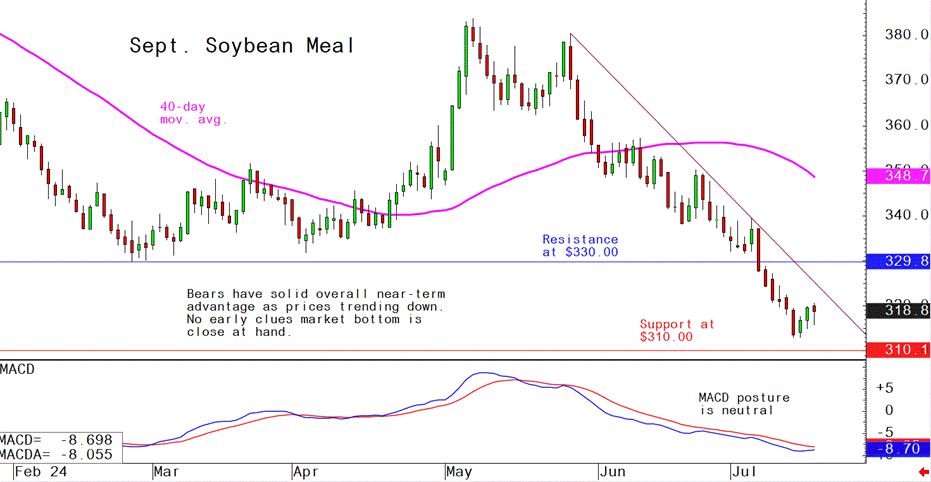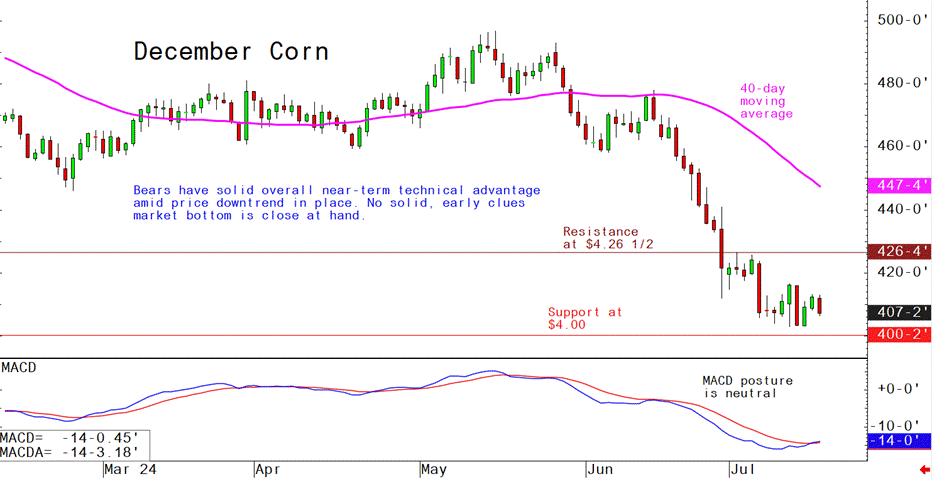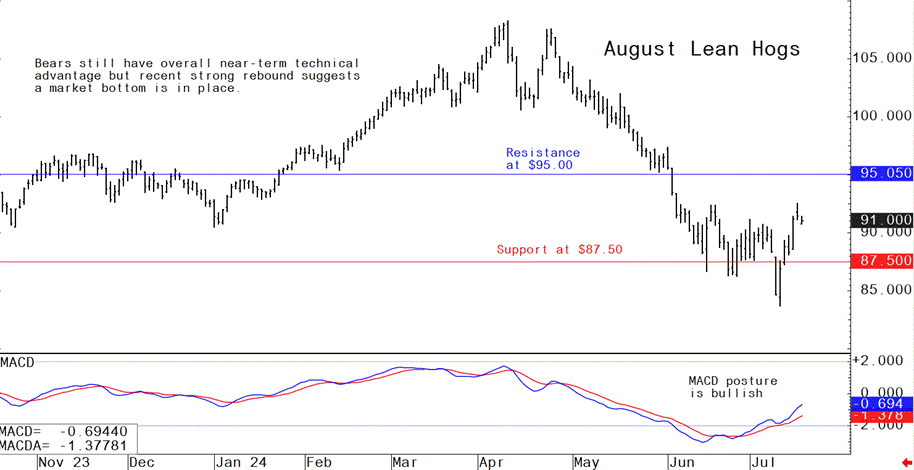



Pig outlook - Lean hog futures see solid price recovery
Jim Wyckoff reports on the latest USDA and other news regarding the global pork industryAugust lean hog futures this week have seen a strong rebound after hitting a contract low on July 11. Technical factors suggest a near-term market bottom is in place. Cash market fundamentals are also improving. The latest CME lean hog index is up 18 cents to $88.80, as of July 16, marking the first three-day string of gains since late-May/early June. August lean hog futures finished Wednesday at a $2.85 premium to the cash index.
Strength in pork cutout value gives hog futures traders confidence an interim low could be in place. Pork cutout rose above $100.00 this week for the first time since June 14. Firming belly values as BLT season is in full swing could continue to support wholesale pork prices. If retailers offer more pork features, taking advantage of the dip in beef demand, the hog complex could continue to be supported by stronger consumer demand in the coming weeks.
China to probe EU pork for anti-dumping
China has put three companies from the European Union at the center of its anti-dumping investigation into pork products from the bloc. Beijing has chosen Danish Crown A/S, Vion Boxtel BV, and Litera Meat S.L.U. — the top three exporters of pork products in the region to China — to determine if dumping has occurred and assess the damage to the domestic sector, the commerce ministry said. The investigation, which began June 17, will look into pork and its by-products imported from the EU after the bloc decided to impose anti-subsidy duties on Chinese electric vehicles.
China’s June pork imports continue to lag
China imported 90,000 MT of pork in June, up 12.5% from May but 33.5% less than last year. Through the first half of 2024, China’s pork imports totaled 520,000 MT, down 45.3% from the same period last year.
Weekly USDA US pork export sales
Pork: Net US sales of 23,700 MT for 2024 were down 11 percent from the previous week and 35 percent from the prior 4-week average. Increases were primarily for Mexico (8,500 MT, including decreases of 600 MT), Japan (3,000 MT, including decreases of 300 MT), China (2,800 MT, including decreases of 100 MT), Colombia (2,100 MT, including decreases of 100 MT), and South Korea (1,900 MT, including decreases of 200 MT). Exports of 31,900 MT were down 2 percent from the previous week, but up 7 percent from the prior 4-week average. The destinations were primarily to Mexico (14,100 MT), Japan (4,600 MT), China (3,100 MT), South Korea (2,200 MT), and Canada (1,800 MT).
China’s Q2 pork output declines
China’s pork production fell 3% from year-ago in the second quarter to 13.98 MMT, following a 0.4% decline in the first quarter. That marked the first consecutive quarterly declines on an annual basis in output since 2020. During the first half of the year, China’s pork output totaled 29.81 MMT, down 1.7% from the same period last year. China slaughtered 363.95 million hogs during the first half of this year, down 3.1% from last year.
USDA monthly livestock report: world pork markets and trade
Decline of China Pork Imports Continues in 2024
The revised 2024 forecast for China pork imports anticipates a 21 percent decline year on year to 1.5 million tons, the lowest since 2019. If realized, 2024 imports will return to similar levels to before China’s outbreaks of African swine fever (ASF), which began to impact China production at the end of 2018. Despite forecast lower imports, China is expected to remain the largest global pork importer. At the peak of ASF outbreaks in 2020, imports accounted for 13 percent of China pork consumption. The import share of consumption has steadily declined since then as domestic production recovered from ASF and returned to pre-ASF levels in 2022. For 2024,
China pork production is forecast 56 percent higher than 2020 and 2024 imports are projected to account for only 3 percent of consumption. Due in part to abundant domestic supplies, stubbornly low pork prices in China since early 2023 have weakened demand for imports. Average reported pork prices were 10 percent lower during the first quarter of 2024 compared to the same period in 2023 and 56 percent lower than the first quarter of 20201.
For many major foreign suppliers, it is difficult for their exports to remain competitive in the China market given low domestic prices. Major global pork suppliers to China – including the European Union, Brazil, and the United States – are expected to seek alternative markets. However, these markets will only partially offset lower China demand. As a result, competition is expected to increase in other large import markets including Japan, South Korea, and the Philippines.
China’s meat imports slump in June
China imported 515,000 MT of meat during June, down 42,000 MT (7.5%) from May and 150,000 MT (22.6%) from year-ago. Through the first half of this year, China imported 3.3 MMT of meat, down 13.4% from the same period last year.
USDA awards $110 million to expand independent meat processing
USDA Secretary Tom Vilsack announced nearly $100 million in new grants to enhance local and regional meat and poultry processing capacity. This funding, part of two initiatives, includes over $83 million for 24 projects in 15 states under the Meat and Poultry Processing Expansion Program (MPPEP) and $26.9 million through the Local Meat Capacity (Local MCap) grant program for 33 projects in 23 states. These efforts align with the Biden administration's goals for fairer, more competitive, and resilient markets. Responding to concerns from House Ag Chair GT Thompson (R-Pa.) about new EPA regulations, Vilsack noted that USDA has collaborated with EPA to minimize any impact on processing capacity, suggesting that concerns about the regulations are exaggerated.
The next week’s likely high-low price trading ranges:
August lean hog futures--$87.00 to 95.00 and with a sideways-higher bias
September soybean meal futures--$310.00 to $332.00, and with a sideways bias
December corn futures--$4.00 to $4.20 and a sideways bias
Latest analytical daily charts lean hog, soybean meal and corn futures










